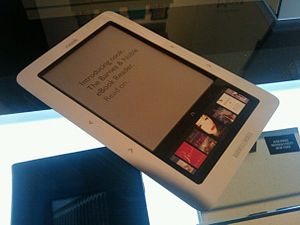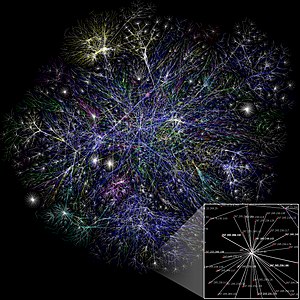
The share of the book market attributable to self-published books is not an easy number to track down. But a lot of folks with skin in the game feel data like this is pretty important now that the indie publishing movement has a few years under its belt. However, if you pay attention to all the bloggers on this subject, its kind of comical how they stretch the math given the paucity of meaningful and transparent numbers.
Market share questions for both indie work and electronic books may in fact be a major red herring that will fade away in the next few years for most of us as writers continue to enhance their creative offerings. Here at the dawn of the economy of the digital story we’re still caught up in the idea of books as distinct chunks of text more or less on par with those rectangular paper things so deeply imbued with meaning for centuries. But should an electronic version of the next, say, Infinite Jest or even Fifty Shades of Grey really just be this singular, quantifiable consumer item that’s tradable, ownable, and easily stored? Or are things a bit more fluid than that?
The Implications of Growth
One of the more valiant industry evaluations I’ve seen recently may be found in David Gaughran’s post from last week called “Self-Publishing Grabs Huge Market Share From Traditional Publishers.” [The link to this article is at the end of this post]. Gaughran uses some gross percentage breakdowns on best-sellers reported by the likes of Barnes & Noble, Amazon, and Kobo to extrapolate for the industry in aggregate, concluding that indie books account for 25%-30% of all books sold these days.
Whether you agree with Gaughran’s math or not, his distinction between revenues and unit sales is important. As I’ve written in a number of places over the past year, indie books are a truly bizarre commodity. Writers so desperately want to get noticed. There’s no data, but it’s pretty clear that free and $0.99 books ensure that revenues from indie sales couldn’t possibly be a very meaningful number compared to units “sold.” So Gaughran’s analysis deserves credit for making that distinction crystal clear.
No matter what, the notion that self-published markets are growing exponentially implies a great deal. First of all, most self-published books are electronic — meaning that folks with Kindles, iPads, Nooks, etc. are driving a huge piece of the consumer puzzle (see below for a bit more on that). And we’ve only just come through the early adopters’ phase of this new technology movement. Wait another five years. Innovators and early adopters tend to represent about 20-25% of a technology market. The next 35% of the market — the early majority — is a big nut. Then we move to what is often called the “late majority” — the final 25% or so of the market (there are always laggards with every technology). It’s only a matter of time.
The interesting thing here is that this particular technology movement is a dual one: part of the shift has to do with writers and publishers; and part of it, the most important part, has to do with reader-consumers. If anything, it seems to me right now the writers and publishers are out in front and it will take a few more years for readers to catch up.
Secondly, this new book market frontier, as it is currently configured, is really only about 4-5 years old. If indeed indie ebooks have already garnered a quarter of the industry’s unit “sales” in such a short period of time, that’s a huge power shift in the publishing world. What’s remarkable here is that such a shift is happening mostly through the efforts of micro-Internet businesses and lone authors and publishers just using the power of social networking, blogs, the Internet, and their preternatural creativity. Imagine what is going to happen over the next five years as these quality businesses grow, and indie authors continue to learn, producing better, more valuable content.
As I noted above, it’s pretty hard to figure out what’s going on just comparing digitally published work to other formats. For instance, Amazon’s current database lists about 105,000 overall new titles posted in the past 30-days. But when you analyze the full spectrum of formats for these titles, the total number of books you come up with is roughly 115,000 books (formats are everything from paperback and digital to audio CDs, MP3s, and cassettes). What’s up with that? Who knows…
That said, it looks like industry sources feel pretty confident that their survey methodology gathering data from about 1200 publishers shows that ebooks represented about 25% of the most important part of the market last year. According to a Publishers Weekly summary of an Association of American Publishers (AAP) study, while overall book sales were down 2% in 2012, adult book sales increased by 5.6% partly due to a 33% rise in adult ebook purchases. Most notably, PW says, “E-books represented 25.8% of all sales in the adult trade segment in 2012, up from 20.4% in 2011 at reporting StatShot publishers.” That 25.8% is all ebooks, not just indies, but those numbers still imply a great deal about the dynamic future of the book world.
The Mating Game

What’s really interesting to me in this new publishing economy is that we’re still drawing a distinction between “self-published” indie authors and those who are traditionally published. In some ways the only differential left is that publishing houses provide turnkey quality control services (from copy editing to marketing and paper printing). That quality control is essential, no doubt. But there are hundreds of independent contract support professionals out there now offering their services to indies.
The thing is, indie writers own their work lock, stock and barrel. Publishers essentially own the work of their authors. In this fast-paced world of new technology, who do you think is going to win in the end?
Most successful indie authors these days (I’m talking everyone from Dean Wesley Smith and J.A. Konrath to Amanda Hocking and E.L. James) are operating in both worlds. Over time it’s likely that most established authors will do the same. So far publishers have shown a pretty shoddy understanding of how to offer digital books (including how to price them). And the rights to back lists that publishers don’t want to invest in anymore will inevitably revert to authors. Why not market these on your own?
So, if I’m right, as we move forward this distinction between indie and published is going to fall away. In fact, I’ll go one step further here. The typical author has a blog, some bag of social networking tools (I use Twitter, Google+, and Facebook), and runs through their day in constant contact with hundreds if not thousands of people because their smartphones, laptops, and tablets are all synched together. As we move to a world where everyone is like that and the vast majority of readable content is given initial primacy as digital copy, isn’t it just a matter of time before books become extensions of blogs, or even, dare I say it, Twitter followers? Or, conversely, that websites and Facebook/Google+/Twitter/YouTube, etc all become extended prefaces, commentary, and afterwords to books?
Blogs and books and iPhones all sleeping together! What a sexy world!
I’m not talking some magical revolution here. It’s already happening…obviously. All sorts of authors offer free books and stories at their websites in exchange for signing onto their mailing lists (look at the top of the right frame here to see my own offering). Writers are crowd-sourcing plots and book topics. And readers can find alternative endings, excised passages, character histories, maps, photos, even video and music connected to books they’ve read.
I’ve been posting draft sections for two novels I am currently working on ever since I geared this website up. You can go back through my entries to find all sorts of funky stuff. You can also check out the “Works-in-Progress” page on my navigation bar. I have several hundred followers of this blog already. That’s small potatoes compared to many of my colleagues.

Thus, to me, in the end the question of market share for the self-published is missing the point. We know it’s growing. The question is how much more does it need to grow before the distinction between indies and traditionally published writers is a non-issue? Remember, the only people for whom that distinction really matters are publishers. Readers don’t really care how a writer came up with a book. They just want a good read. And you as a writer should really only be concerned with how to connect with those readers. If a publisher can convince you they have the best way to do things, then by all means you should work with them. But if they’re asking you to sign a contract, you better know what it says. I’m sure if I had a deal with a publisher (or even an agent) all the sample passages and alternative drafts I’ve been publishing would not be allowed. And getting a third edition of my novel out there by the end of the year? Fuh-getabow-tit.
What really matters is that writers of all ilk get out in front in the content game and then stay in front. That means gaining an easy facility in using current social networking tools, and then figuring out how to mesh those tools with new work you’re preparing. (Watch these pages for more free stuff and a special music edition of my psychedelic novel Beyond the Will of God sometime this summer).
Mating the stories and content you offer for sale at places like Amazon and Smashwords with that all important platform every “how-to-be-an-indie-author” webpage discusses is a fabulous opportunity to get funky and creative.The Internet is exploding with new apps, new networking territory, and new ways to distribute content to an audience of billions. Publishing houses and re-sellers like Amazon and B&N are still caught up in thinking that books are discrete and separate commodities that they can own or control. Nothing could be further from the truth. Everything is fluid in this digital universe. If it’s on your screen, you control it. It’s as simple as that.
The goal is not to control your reader or take money from him or her. It’s to communicate with them; it’s about providing unique value and interesting stories. If you do that, people will buy your work. They’ll buy your work, and they’ll subscribe to your blog, and they’ll come back for more over and over again. Don’t think like you’re living in the year 2013. If you know what you’re doing, it’s actually 2018 and the world is everyone’s oyster.






Those last two paragraphs say it all, David. Creating and selling books should be all about the reader–interacting with them, yes, but ultimately and most importantly giving them a satisfying read, one that they will WANT to widely discuss through social media. Readers want quality work for the money they spend, and our main goal as authors should be to see that they get that from us. I have to say also, that I get a bit fired up when I think about the limitations placed on authors by traditional publishers. Indie authors have made, and are continuing to make, a powerful statement–that is, that they can be in control of every aspect of their published work without restraints set upon them by traditional publishers– and be successful at it. This is a heady freedom. But a freedom that also comes with great responsibility.
As always, your blogs are thought-provoking and informative. Thanks for your insights and prophetic predictions. I think they’re right on.
[…] at new speeds and spin into a different dimension. I’ve touched on that issue in this blog on and off over the past year. I’ve also touched on it in some of my columns for Talking Writing […]